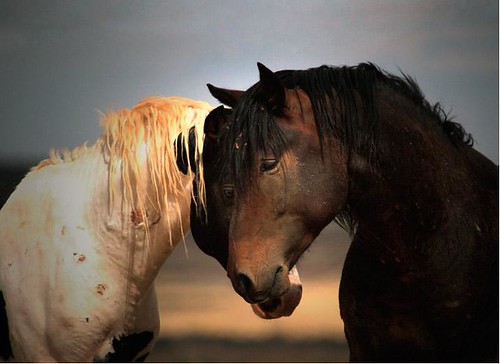tags: wild stallions, National Geographic, international photography contest, image of the day
Wild Stallions
Image: Chris Gimmeson,
Nature Honorable Mention,
2008 International Photography Contest [larger view].
The photographer writes:
These are two wild stallions from the McCullough Peak's herd of wild horses, which is located just outside of Cody, Wyoming. This image was taken in September 2008 with a Canon Rebel XSI and a long telephoto lens. I expected them to fight but they went back to grazing after a minute of posturing. The peaks area is pretty desolate, with little in the way of water supply and a lack of trees. The main staple for their grazing is sagebrush.
There's lots more gorgeous images here for you to enjoy!
More like this
tags: researchblogging.org, champion racehorses,
This poem seemed really fitting with the last post, yet I couldn’t fit it in anywhere. So here it is, all by itself, with some strange guy reciting it next to an egg cart:
I always assumed that the best race horses simply had the best genes. It seemed like the kind of domain where nature trumped nurture, where the genetics of fast twitch fibers and heart size was more important than the details of training.
Maybe "wacky" isn't the right word — if you read through this collection of Russian jokes translated by Mark Perakh, you might find some are fairly funny, others are completely opaque and strange, and others drop with a leaden thum


Feral stallions would be more accurate.
yes, but they don't know they're feral!
(besides, what is the time limit for feral-ness? horses did, after all, evolve in north america)
Too often we do not see that stallions are not the fire breathing dragons they are made out to be. Stallions that are raised in a herd environment often meet and greet other stallions who aren't challenging them for the mares.
Maybe, but that pinto on the left sure has a lot of battle scars! I imagine the bay does as well, we just can't see them.
Mmm...I think feralness is pretty much a permanent condition. Cows =/= bison, German Shepherds =/= wolves, domestic horses =/= extinct native horses. Lovely animals in the appropriate setting, just not a part of our native ecosystems.
Excellent!
"Maybe, but that pinto on the left sure has a lot of battle scars! "
or just scars, not battle scars. Many of the horses turned out in pastures have scars too. Boys tend to play rough, mock fighting, biting and kicking at one another. This is not to say that fighting does not occur, it does, but many times meeting is greeting, not aggression. And in a herd environment, it is more evident.
I LOVE this photo, the way the 2 horses come together! I am a young equestrian and photographer and I love taking pictures of horses! They are my favorite subject. Come visit me at http://www.stabledays.typepad.com.
Your Horse Pal,
@raya